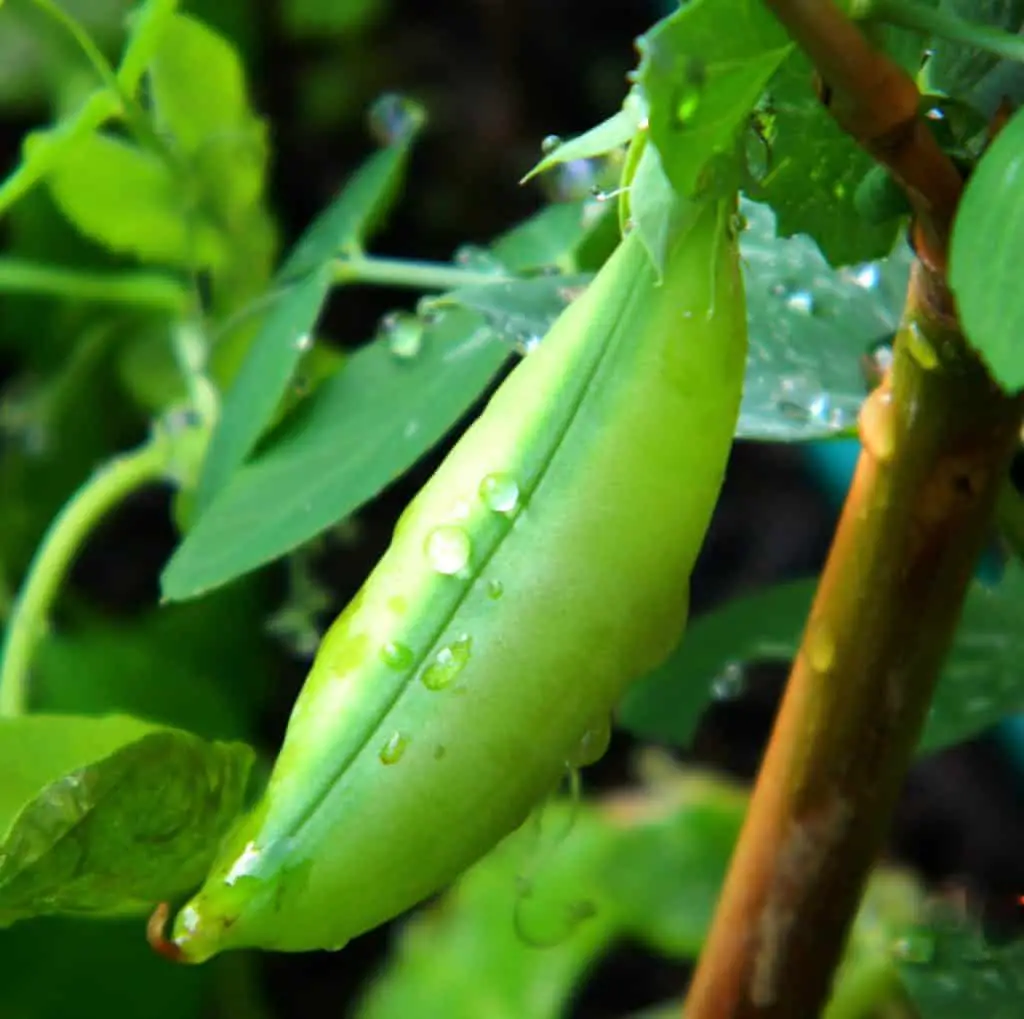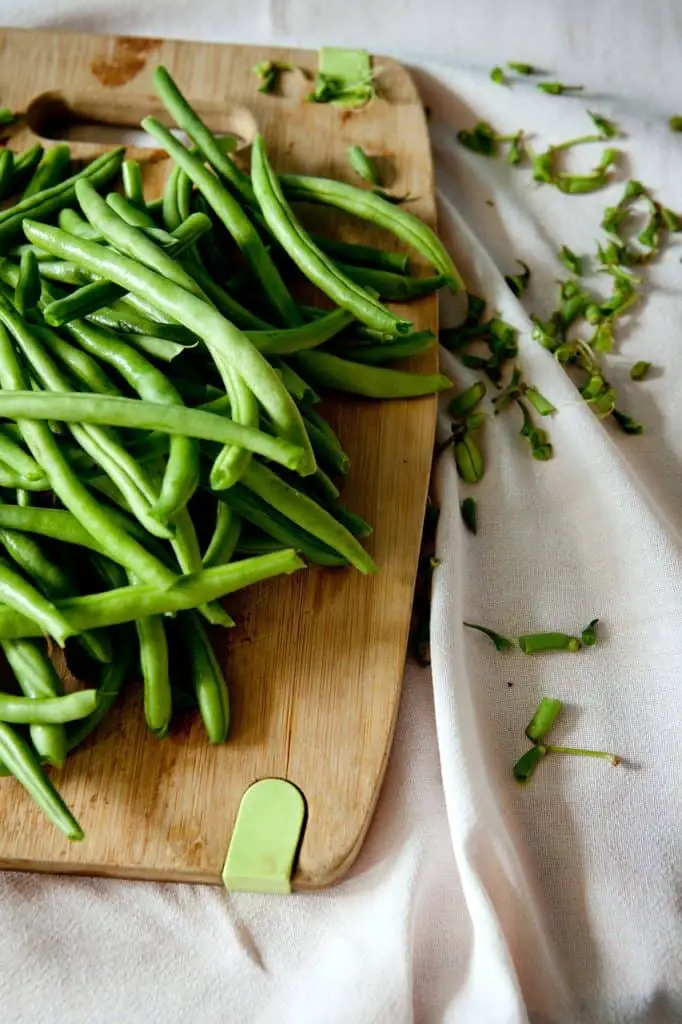Growing fresh beans in a container is quite easy and very rewarding. In this guide, I will tell you everything you need to know in order to grow healthy beans at home.
The idea of having luscious veggies grown in your backyard is tempting, and when you come to think of it, fresh home-grown vegetables have a special flavor about them.
Hence, before you grow those beautiful and vibrant green beans you must educate yourself in certain areas and look at some things to guarantee, that you get the most fruitful harvest.
So let´s get started and take a look at the most important things to know before you grow your own green beans inside pots.
Types Of Green Beans
Firstly, there is a whole gamut and varietys of green beans.
Broadly classifying they are two kinds, the ones that are known as string beans and the others that are stringless.
However, there can also be beans that are found in colors other than green, like yellow purple and red, but the ones we usually grow in our backyards in pots or containers are green in color.
Green bean plants show some amount of variety as well. There are the long ones that are slender and grow higher in length but are sparse and require the support of a pole to grow.
And then there are the comparatively shorter ones with stunted growth but the plants being more thick and bushy.
The variety that you would like to plant depends on the amount of space you are able to spare for the plants.
Usually, the smaller, bushier variety is preferred over the longer ones because they take up minimal space and are perfectly suited for growing in pots or containers.
Variety Of Beans That Are Best For Growing In Pots
Since we’ve already discussed how the small and bushy variety of green beans are more convenient for growing in places where there is space crunch. Let’s break down the best varieties of the same that offer great harvest and are delicious in taste:
Blue Lake 247
A beautiful variety of long and slender beans, which are also plump, firm and tender all at once.
The texture is smooth and pods are rounded in structure. Delicious and heavy yielding variety that takes about 50-70 days to yield.
Definitely a great choice for growing in pots.
Kentucky Wonder
Also known as Old Homestead, this one has both the string pole variety as well as the bushy one.
The bushy variety has great flavor and is about 8 inches in length with flattened pods. High yielding variety that grows over a period of 52 to 65 days and grows in almost any weather conditions.
Contender
Looks fresh and luscious green, and smooth textured.
Slightly curved, with buffed seeds and the pods being six to eight inches in length. The bush itself is twelve to twenty inches tall, making it convenient for smaller spaces. The beans are fresh and taste good.
Harvest is good and quicker than other varieties, approximately forty to fifty days, and the bush can tolerate medium heat and mildly wet conditions.
Bountiful
This variety is excellent in flavor and is an heirloom species which makes it even more wholesome in its goodness.
The pods are slender and slightly curved with flattened seeds, and the beans are dark green in color. The harvest is quick and good.
Derby
Great flavored beans, dark green in color and straight pods with slightly rounded seeds.
The pods are about eight inches long, but best when harvested when tender at six inches in length. Can be grown in almost all weather conditions.
There are a whole lot of other varieties of green beans like Greencrop, Harvester, Romanobush and much more. But the above mentioned varieties are the easiest to grow in containers.
There are some green beans that are longer and require the support of a pole, though they are a bit of a hassle to take care of, here’s a breakdown of some of the best snap-pole beans, as they are called.
Blue Lake
Bean lake is available in snap-pole variety as well. These taste sweet and juicy and have oval seeds. The pods are seven to eight inches long, and they also can survive in almost all weather conditions.
Lazy Housewife
This is a German variety of heirloom pole bean. With a smooth texture and slender in shape, with slightly oval seeds. The variety is rich and tasty.
Kentucky Blue
This is yet another great variety of green beans that are sweet and juicy. The pods are straight and eight inches long. Takes around fifty-five to sixty days to grow.
Container Size Required To Grow Green Beans
Knowledge about container size and depth into with the bean seeds would be sown is critical to the healthy growth of the plant.
You don’t want to choose a very small container and use too many seedlings or seeds to cram up the pot and stunt the easy growth of the plant.
A pot or container of standard size should be suitable depending on the number of seedlings you are planning to plant.
For instance, for healthy growth, on an average 9 plants are perfect for occupying 12 inches of surface space. Keeping this figure in mind you can go ahead and choose the pot or container accordingly.
Taking into account the depth of the container is equally important. For example, snap pole beans require a soil depth of at least 8 to 9 inches, whereas, bush varieties thrive in soil depth of 6 to 7 inches.
There are other factors regarding the pot that need to be considered-the drainage and breathability of the material of the pot. When choosing a container, make sure that there are enough drainage holes as outlets for excess water, you don’t want your plants to be potted in a damp condition all the time.
The shape of the pot does not matter as such, but, unglazed pots offer much more breathability to the plants.
The Type Of Soil Required To Grow Green Beans
The ideal soil type for growing green beans is sandy and silty loamy soil.
But since this perfect balance of the ideal soil is not readily available and accessible to someone who wants to grow beans in a pot, any soil will do.
Green beans have the capability to grow and yield fruitfully in any kind of soil except for clayey soil. The constant amount of moisture that clayey soil provides is harmful to the root strength of these plants.
There are also green beans and other vegetable potting mixes available in the market which can be mixed with the soil to make a great pot garden for the seedlings.
Manure
Green beans are leguminous plants which means their root nodules contain rhizobium bacteria for nitrogen fixation from the atmosphere into the soil, making it fertile.
But organic matter or liquid vegetable fertilizer can be added from time to time for better results in growth and production.
How to Take Care for Green Beans

Watering
Green beans require an adequate amount of water to flourish.
They need 1-1.5 inches of water per week. Regular checking if the topsoil is dry and then watering it is also an essential part of taking care of potted bean plants.
Fertilizer
Fertilizing once or twice a month will suffice in the growth of the plant.
Organic compost or liquid vegetable fertilizer are the most appropriate for this purpose.
Light
An ample amount of sunlight is ideal for a green bean plant because dry conditions are most suitable for the best harvest.
However, extreme heat might also be dangerous for the plants, and hence they might require some sort of shade during the summer heat.
The heat and the light also help the plants remain dry and free from fungal infections.
Support
Pole beans require some sort of support to entwine and grow in length.
Hence, some kind of pole or stick inserted along the depth of the soil is ideal for the plant to take support and grow along with it.
Harvest
The harvesting period of bush beans arrives quicker than that of pole beans.

Bush beans are ready to be plucked by 50-55 days, whereas, pole beans take 55-60 days.
It is advisable to wait till the beans get firm before they are plucked out. Also, if the beans are harvested long after the seeds start to grow in size, the beans become old and tough.
There are specific techniques also to harvest green beans. When plucking, it should be done by gently pulling the bean from the plant. They can also be snapped at their ends, which is a much easier process.
Pest And Disease Control
Green beans plants like any other crop are susceptible to infections and prey to pests.
Pests like Mexican bean beetles, Japanese beetles and slugs are the most pestering to the plants.
These can be avoided to a certain extent by drip irrigating the plants which eliminate the risk of having any unwanted body on the leaves.
Fungal infections like Alternaria or Angular leaf spot are common diseases in green beans plants.
These diseases thrive in damp conditions and can take a serious toll on the growth and health of the plant.
Only by keeping the pots or containers out in the sunlight and in dry conditions can these diseases be avoided.
That was a complete and detailed breakdown that hopefully helps you with making informed gardening choices while growing green beans in pots for healthy, high-yielding and tasty green beans. Happy pot gardening!
